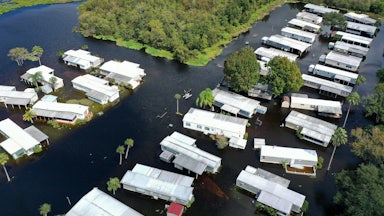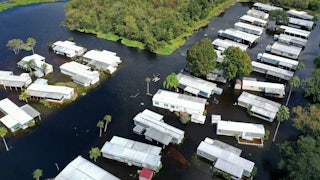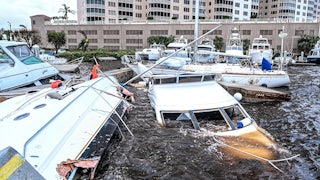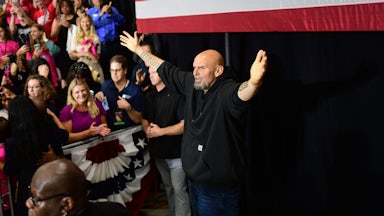The full extent of the damage caused by Hurricane Ian is still being tallied. The death toll—which now stands at 120—rises by the day. As those living in the storm’s path attempt to rebuild, they may now also have to deal with the downstream effects of a crisis in pristine, far-off boardrooms. According to a new analysis by Stonybrook Capital, Ian may be the single biggest insured loss ever, totaling an estimated $75 billion. The company warns that the effect on the insurance market could be “profound and widespread.”
For years, the insurance industry has devised increasingly complex ways to maintain a steady stream of profits. But as climate-fueled disasters keep mounting, that creativity may be reaching its limits. Policymakers too are running up against limits on their longtime strategy of passing the buck for climate recovery and resilience to a sector that was never meant to provide them.
About half of the residential mortgage market is backed by agencies regulated by the Federal Housing Finance Agency, including Fannie Mae and Freddie Mac. If you need to get a federally backed mortgage, then you need homeowners’ insurance. Those policies cover damages from wind and fires but not floods. Flood insurance is similarly mandatory for most mortgage borrowers in flood-prone areas, and subsidized by the National Flood Insurance Program, which reimburses losses up to $250,000 under the umbrella of the Federal Emergency Management Agency. That can leave serious gaps, particularly in high-cost and rapidly growing areas like Florida’s Western Coast. Enforcement on who takes out flood insurance is lax, and many areas where homeowners aren’t required to carry it have, in fact, been flooded. Those with coverage could still pay dearly to rebuild. Mortgage borrowers in Cape Coral and Fort Meyers, for instance, have an average of $316,499 in equity wrapped up in their homes.
Insurers themselves take out insurance to protect against massive losses. Typically those policies, known as reinsurance, are issued by companies based in Europe or on Wall Street like Munich Re or Swiss Re. But escalating costs amid an uptick of disasters has made insuring the insurers an increasingly expensive prospect.
In reaction to a string of destructive storms in 2004 and 2005, including Hurricane Katrina, reinsurers began to experiment with something known as insurance-linked securities, or ILS, including catastrophe bonds (“cat bonds”). Not unlike mortgage-backed securities, cat bonds bundle together reinsurance and insurance companies’ exposure to different forms of risk—like California fires and Florida hurricanes—into a financial product with its own risk portfolio.
That risk is determined by complex, proprietary modeling that has grown up around the novel asset class. Zac Taylor, a professor at Delft University of Technology who studies climate risk and the insurance sector, writes that such modeling has “helped to transform amorphous climate uncertainties into exchangeable risk objects, into ‘just another asset class.’” If a single catastrophe rises above a certain predetermined damage threshold, then raised funds go back to the sponsor of the bond to pay out claims. If it doesn’t, then investors continue to collect interest. Essentially, cat bonds ask investors to place a well-informed bet on the weather.
After the financial crisis, ILS products took off as institutional investors like hedge funds and pension funds went searching for reliable sources of yield that weren’t so directly tied to the rest of the economy. But financial markets will only shoulder so much risk. While the full effect of Ian on the ILS market remains to be seen, Stonybrook Capital’s report paints a bleak picture: “Many diversified Cat funds are now deep in the red for the year (if not earlier), and all will have ‘trapped capital’ again. Some will now report experience that is far below their investor representations in 5 of the last 7 years.” The ripple effects of that could be profound, leading to a dramatic rise in prices for policyholders. Making matters worse is the fact that the Federal Reserve is also hiking interest rates, potentially rendering cat bonds less attractive to institutional investors who can find better returns elsewhere.
Though it’s a critical lifeline to people rebuilding from climate-fueled disasters, the insurance industry isn’t preternaturally well equipped to weather rising seas and temperatures. Historically, insurance has protected against seemingly random and uncorrelated events, from car accidents to lightning strikes, kitchen fires, and burglary. “The problem with climate change is that now you have a systemic risk that’s getting worse. You don’t have a random pool where some people will be OK and some people won’t,” said Rachel Cleetus, policy director with the Climate and Energy program at the Union of Concerned Scientists. That assertion is backed by data: According to a recent report from the National Oceanic and Atmospheric Administration, the number of billion-dollar weather-related disasters per year is rising. In coastal states like Florida, Cleetus adds, “you find out that almost everybody is exposed.”
In the United States, that exposure can be especially devastating. Property here often functions as a safety net to help fund things that in other countries are provided by the state. Taking out a second mortgage on the house, for example, can help pay for college. The real estate sector also accounts for roughly 20 percent of Florida’s gross domestic product, giving lawmakers a particular interest in its investments.
“We have a financial market engineered by leverage on fixed assets,” explains Zac Taylor, who also grew up in Tampa. “A lot of our wealth and our economic activity is really built on real estate, and that’s increasingly pressurized by climate change. Florida is in some ways exceptional but also an insight into the future.”
As Zachary Coleman and Katy O’Donnell reported for Politico this week, many of the middle-class retirees who have flocked to Florida depend on fixed incomes and reverse mortgages that allow homeowners who have paid off their mortgage to borrow cash against their property. If they poured life savings into purchasing homes up front, meaning they weren’t required to take out insurance, they could now be left to foot the bill for storm damage. Hurricane Ian—and the insurance troubles it exacerbated—adds to what was already being described as a housing crisis in Florida, where home prices and rents have been rising at a rapid clip amid a spate of development in the areas worst hit by Ian.
“Before the storm hit, Florida already faced a severe shortage of affordable housing,” said Anne Ray, manager of the Florida Housing Data Clearinghouse at the University of Florida’s Shimberg Center for Housing Studies. She’s been working with the state officials in Florida to assess the full extent of the damage from Ian. “We generate a lot of jobs in our state in the service industry,” including low-paid work in tourism and retirement communities, she added. “Housing costs have risen much faster than those wages have. There was already a gap between what housing costs and what many workers could afford to pay. Now more people are searching for housing and many units are damaged.”
As with housing policy, when it comes to insurance it can be hard to parse the lines between the private and public sectors; Taylor describes them as “mutually constitutive.” The real estate sector is propped up by a string of federal bodies and incentives created in no small part to make property ownership the center of American economic life. Insurance is meant to protect those assets, and the industry similarly functions through an elaborate matrix of government support.
Florida offers a tidy case study of how this house of cards has been erected over the past few decades. After Hurricane Andrew in 1992, major insurers fled the Sunshine State and several went bankrupt. When the remaining insurers wanted to raise rates—prompting outrage across the political spectrum—the state stepped in with its own options. Creating public insurers of last resort set a de facto price cap on policies, forcing already struggling private providers to compete with the lower rates offered by the state-backed Florida Residential Property and Casualty Joint Underwriting Association and the Florida Windstorm Underwriting Association. Those were eventually consolidated into the Citizens Property Insurance Corporation, which has parallels in other hurricane-prone states like Texas and Louisiana. Citizens accounts for about 15 percent of Florida’s insurance market and covers a million people overall, concentrated in high-risk areas like Miami. If insurance companies fail, the state-backed Florida Insurance Guaranty Association is there to bail them out. To protect against catastrophic losses, Citizens created its own reinsurer called Everglades Re, which has been especially active in sponsoring cat bonds. Investors in those bonds include Florida state pension funds. Between 2015 and 2017, Florida’s State Board of Administration—which manages state pensions—allocated at least $765 million to just five ILS funds via proceeds from state retirement funds.
During Governor Rick Scott’s tenure, Florida tried to reduce the number of people this state plan was insuring, transferring millions of Citizens policies to private companies. Taylor explains that a number of insurance companies were created from scratch to take advantage of new subsidies created to incentivize firms to take on new customers. One of the results, however, was that Citizens has been left with some of the state’s riskiest policies.
That push coincided with a period of rapid development and prolific investments in real estate. As NPR’s Jenny Staletovich and Nick Underwood recently noted, Florida moved in 2011 to abolish an agency created to place limits on the kind of growth boom that has taken place in the region over the last decade.
This all created a kind of ticking time bomb for Florida, whose insurance market looked rickety even before Ian hit; six insurers had already gone bankrupt this year before Ian made landfall. Thanks to the fact that Western Florida hadn’t dealt with a major storm for a century, policies offered in those areas were relatively cheap. Accordingly, those policies may not be able to cover all of Ian’s damage.
Whereas major insurers like Allstate tend to be exposed to risks from around the country, the genre of small, private providers that has cropped up in Florida in recent years is exposed mainly to risks in Florida. Besides making insurers vulnerable to any major events in their coverage areas, that concentration also makes it difficult to get reinsurance. Just this week, Louisiana Citizens Property Insurance Group—a parallel to Florida Citizens—announced it will raise rates for new and renewed residential property insurance policies by 63 percent. “The rate increase is almost totally a result of the increased cost of reinsurance for Citizens’ increased number of policies this hurricane season,” the state’s insurance regulator said after approving the hike. Many fear similarly drastic changes could be coming to Florida, all as rising prices from providers stand to send more customers to Citizens.
The growth of the ILS market, Taylor said, emerged from a “recognition that there needed to be new forms of capital. But the reinsurance industry can only absorb so much risk from one place while doing so at a price that can be competitive in that place.”
Now that the era of cheap money and stable temperatures is coming to an end, both Florida and the broader insurance industry face a potential crisis. Policymakers have been relying on the insurance sector to bail out bad or nonexistent planning, stepping in to prop them up with state funds as needed when things that probably shouldn’t have been built get predictably wiped out. As seas rise and losses mount, the public sector may well continue to shoulder more of the risk and almost none of the rewards.
Some in the insurance industry are bullish about their prospects in a warming world. Greg Case, CEO of the risk-mitigation firm Aon, recently described the climate crisis as a “generational opportunity,” at a Monte Carlo meeting of insurance and reinsurance executives organized by the consultancy PwC. “In many aspects, climate change is going to drive the largest relocation of capital in history. Climate change is tangible risk; it’s what we do every day. The impact is immediate. It’s measurable,” Case said. “This is a tremendous opportunity.”
He went on to note the importance of the insurance sector in directing flows of capital, as it works to “help capital understand I can make that investment with less volatility,” Case explained. “My view, this is the chance for us to do something that is beautiful and extraordinary.”
But protecting people and protecting profits are two different things. Doing both, as Taylor has written, requires a fragile, potentially untenable balance. Even experts who see the insurance sector as being able to play an important role in navigating the climate crisis are also wary that so much critical information about climate risk is in private hands. As Case seemed to indicate, that knowledge could soon become an even more precious commodity.
Despite numerous warning signs from the U.S., the global insurance market is increasingly being treated as a major solution to climate risks. The European Union last week signaled that it won’t back long-standing calls from climate-vulnerable countries for a dedicated loss and damage fund at forthcoming U.N. climate talks. The bloc intends to lean instead on “international initiatives designed to better shield developing countries from the adverse effects of climate change, including by mobilizing innovative tools and sources of finance, such as the G7 initiative of the Global Shield against Climate Risks.” The Global Shield is an insurance coordination scheme launched at the G7 summit last summer to pool funds for so-called parametric insurance, which is triggered automatically by certain extreme weather conditions.
Insurance is a poor substitute for loss and damage financing, though. “It’s not as simple as asking where you are going to rebuild that house that’s being repeatedly flooded and washed away. Where are you going to rebuild the livelihood you’re drawing from a place that is no longer there? Insurance on its own is not going to be able to deal with that level of complexity,” Cleetus told me. “We need financing unlocked from richer countries and pathways out of risk, for people to move to safer places. It’s important to see insurance for what it is and what it isn’t. There is sometimes a simplistic narrative that if only everyone had insurance, we’d be fine. That’s not true.”










